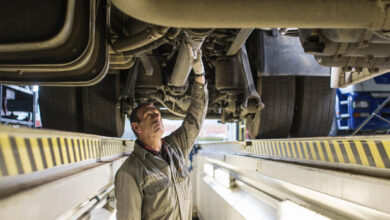Why Winter Weather Can Affect a 3-Garage Door

A garage door is made up of a system with many moving parts. These parts can be affected by temperature changes, especially during winter. If you have experienced your garage door failing to shut or open at any moment, you would understand how frustrating it can be. A garage door that fails to function correctly will lead to you being stranded at home because the garage door won’t open, or the cold weather could seep into your home because the door won’t shut.
The importance of having a garage during winter cannot be overstated. It prevents your vehicle against harsh weather conditions, prevents cold from penetrating your house, and gives a safe environment for you to enter and leave your home.
Yet, winter can wreak havoc on your 3-garage door systems, resulting in unwanted breakages, warping, and delays. The repairs are often costly and inconvenient, but you can perform preventive maintenance before winter sets in. This article unpacks some of the problems the cold winter weather will have on your 3-garage door.
Damaged Weather Stripping
The first of 3 garage door problems that surface during winter is damaged weather stripping. There are constant fluctuations of temperature during a 24-hour duration that causes the snow outside the garage door to start melting and then refreeze. This can take place severally in a day, depending on where you reside. Consequently, your door will start sticking to the ground.
When you open the door, the weather stripping at the bottom is peeled off, compromising the door’s seal. A damaged stripping will allow cold air and moisture to seep into the garage, and it can affect many components. Tracks and motion sensors are sensitive to low temperatures, so it is crucial to fix the weather stripping as fast as possible.
Slow Opening of the Garage Door
Slow-opening garage doors is a problem that many people need help with. Winter temperatures affect garage door parts such as tracks, rollers, and the opener. Lubrication within the tracks typically hardens when the temperature freezes, making it difficult for the rollers to move on the track. However, inadequate track lubrication can cause a similar effect.
Check the track if your garage door is opening slowly. Check the torsion spring or opener motor if there are no issues with the track. You will need the help of a garage door technician to establish these issues. So, ensure you call a professional to find and fix the issue.
Broken Springs
Broken springs are another way the cold weather can affect your garage door due to wear and tear. Springs last for 10,000 cycles, and many forget to perform regular maintenance checks during cold weather.
You can examine the springs using a simple manual lift test. To do this, lift the door halfway and let go of it. The springs are not the problem if it remains in that position. However, you will need to replace the springs if it starts sinking.
Another way you can prevent broken springs is by installing a safety cable. You will not have to fret once you take care of the installation before the springs break. The safety cable will exert enough force to act as the weight counter of the door. Remember, you need to call an expert if your spring breaks even with a safety cable installed.
Lubrication Problems
Garage door openers must stay lubricated throughout the year to keep moving parts running smoothly. It is common for these parts to change consistency during winter due to the cold temperature. This poses a significant challenge to the garage door opener and every moving part that needs lubrication.
You can confirm whether you have lubrication issues by lifting the door manually. If the door gets stuck at different points on its way up, it has a lubrication problem. The challenge could stem from thickened lubrication or from inconsistently spreading around. One way to address this challenge is to apply lubrication with a viscosity rating that suits the lowest temperatures recorded in your area.
Warped Metal
The metal parts of your 3-garage door might be the source of the problem if you are having difficulty lifting the door manually and the lubrication is satisfactory. Metal contracts slightly in cold temperatures, tightening the lifting mechanisms’ parts. In some scenarios, the tightening results in enough resistance between connecting parts that they cannot move. Consequently, the door gets stuck. Lubricants can address the problem by allowing the parts to slide past one another easily. However, you should reach out to a professional if the problem persists.
Ice Between Panels
Most garage doors have multiple panels that allow them to fold and bend as they move upwards. Regrettably, the panels’ connection points allow room for moisture to settle and freeze. The panels can’t fold once frozen together, preventing the door from opening.
There are many ways of addressing ice between panels. You can try scraping, pouring hot water, using a heat gun, or waiting for the ice to melt. You should ensure you are not damaging the door while trying to remove the ice between panels. For example, you cannot use a heat gun if your door is made of wood.
Sensitive Photo-Eye
Another major challenge during cold weather is a sensitive photo-eye. This is the sensor at the garage opening’s base that detects objects in the path of the door. If it detects any project, it ensures the door does not close and nothing gets damaged.
The challenge with photo-eyes is that they rely on some sensitivity level which can cause them to interpret certain things as obstacles when they are not. For instance, thickening lubrication may be interpreted as an obstacle, especially when setting the sensitivity on “light.”
The photo-eye can also get fogged by the cold, distorting its view. It could therefore react to condensation as an obstacle. The sensor will tell the door not to move when you press the remote. Ensure you treat the lubrication and clean the lens to sort out this issue.
Wrapping Up
Garage doors are susceptible to malfunction and damage during the winter weather. The cold temperatures can make the doors stiff, while snow and ice can damage the door and opener, affecting the overall performance of the garage door. Ensure you take the requisite steps before the cold sets in so the door remain in good condition during winter.
Author Bio
A content specialist in different niches from last 5 years. She likes to read and travel in her free time.She has worked with Elite Garage Door & Gate Repair .





